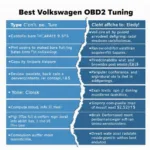The OBD2 コネクタ, or OBD2 connector, is a standardized 16-pin port found in most vehicles manufactured after 1996. This crucial interface allows you to connect an OBD2 scanner and access a wealth of information about your car’s performance, emissions, and potential issues. Understanding how this connector works is essential for anyone interested in DIY car maintenance or professional diagnostics.
Decoding the OBD2 コネクタ (Connector): Pin by Pin
The OBD2 connector isn’t just a random assortment of pins. Each pin has a specific function, designed to transmit data related to various vehicle systems. Let’s break down what each pin does:
- Pin 1: Not used in most cases
- Pin 2: J1850 Bus+ (for certain vehicle makes)
- Pin 3: Not used in most cases
- Pin 4: Chassis Ground
- Pin 5: Signal Ground
- Pin 6: CAN High (J-2284)
- Pin 7: ISO 9141-2 K-Line
- Pin 8: Not used in most cases
- Pin 9: Not used in most cases
- Pin 10: J1850 Bus- (for certain vehicle makes)
- Pin 11: Not used in most cases
- Pin 12: Not used in most cases
- Pin 13: Not used in most cases
- Pin 14: CAN Low (J-2284)
- Pin 15: ISO 9141-2 L-Line
- Pin 16: Battery Power
This standardized pinout allows for universal compatibility with OBD2 scanners, regardless of the vehicle’s make or model (within the supported years).
Why is the OBD2 コネクタ (Connector) So Important?
The OBD2 connector revolutionized vehicle diagnostics. Prior to standardization, accessing diagnostic information required specialized tools and knowledge specific to each make and model. The OBD2 standard streamlined this process, making it easier and more affordable for both professionals and car enthusiasts to monitor and troubleshoot vehicle issues.
Benefits of Using the OBD2 コネクタ
- Early Problem Detection: By reading diagnostic trouble codes (DTCs) through the obd2 コネクタ, you can identify potential problems before they become major issues, saving you time and money on repairs.
- Improved Fuel Efficiency: Monitoring fuel system parameters via the OBD2 connector can help you optimize your driving habits and improve your car’s fuel economy.
- Enhanced Vehicle Performance: Accessing performance data through the connector can help you identify areas for improvement and optimize your car’s overall performance.
- Emissions Monitoring: The OBD2 system plays a crucial role in monitoring vehicle emissions, ensuring compliance with environmental regulations.
Locating Your OBD2 コネクタ (Connector)
The OBD2 connector is typically located within the driver’s reach, often under the dashboard or near the steering column. However, its exact location can vary depending on the vehicle make and model. Consult your owner’s manual for the precise location of your car’s OBD2 コネクタ.
What if I Can’t Find My OBD2 コネクタ?
If you are having difficulty locating the connector, online resources and forums dedicated to specific makes and models can be helpful.
“Knowing where your OBD2 connector is located is the first step towards taking control of your vehicle’s diagnostics,” says automotive expert, Michael Davis, ASE Certified Master Technician.
Common Issues with the OBD2 コネクタ (Connector)
While the OBD2 connector is generally reliable, issues can sometimes arise. Loose or corroded pins, damaged wiring, and blown fuses can all prevent proper communication between the scanner and the vehicle’s computer.
Troubleshooting OBD2 Connector Problems
- Check the Fuse: Ensure the fuse related to the OBD2 system is intact.
- Inspect the Connector: Look for any signs of damage or corrosion on the connector and its pins.
- Verify Wiring: Check the wiring leading to the connector for any breaks or damage.
Conclusion
The OBD2 コネクタ (connector) is a vital component for accessing your vehicle’s diagnostic information. Understanding its function, location, and potential issues empowers you to take control of your car’s maintenance and performance. By leveraging the power of the OBD2 connector, you can ensure your vehicle runs smoothly, efficiently, and safely for years to come.
FAQ
- What does OBD2 stand for? On-Board Diagnostics, Second Generation.
- Are all OBD2 connectors the same? Yes, the physical connector is standardized, but the communication protocols can vary.
- Can I use any OBD2 scanner on my car? Most scanners are compatible with a wide range of vehicles, but checking compatibility is always recommended.
- What are DTCs? Diagnostic Trouble Codes, which indicate specific malfunctions within the vehicle’s systems.
- How often should I check my car with an OBD2 scanner? Regular checks, especially before long trips, are recommended.
- Can I clear DTCs myself? Yes, but it’s important to address the underlying issue that caused the code.
- What if my OBD2 port is not working? Check the fuse, inspect the connector for damage, and verify the wiring.
Need further assistance? Contact us via WhatsApp: +1(641)206-8880, Email: [email protected] or visit us at 789 Elm Street, San Francisco, CA 94102, USA. We have a 24/7 customer support team ready to help.

